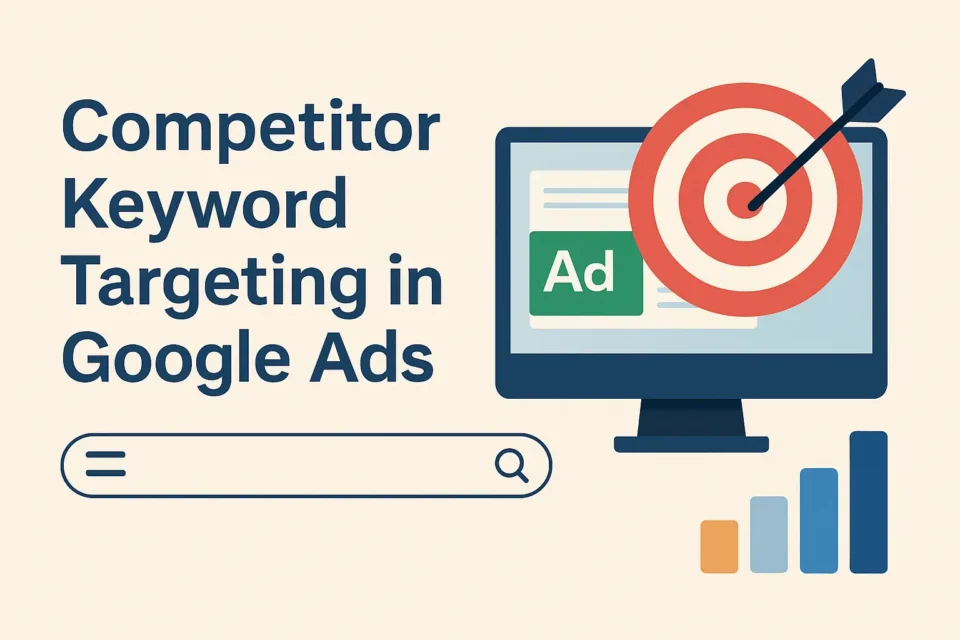Feeling Invisible as a New Brand? This Trick Might Help
Starting a new business is thrilling—but getting noticed online can be tough. One powerful solution? Keyword targeting in Google Ads—specifically targeting your competitors’ names to boost visibility fast.
Thank you for reading this post, don't forget to subscribe!The answer: competitor keyword targeting in Google Ads.
It sounds a bit advanced, but trust me—once you get the hang of it, it’s one of the smartest ways to grow brand awareness (especially when your budget is tight and your brand is new).
What Is Keyword Targeting in Google Ads?
Keyword targeting in Google Ads means placing your ads in front of users who are searching for specific terms—like competitor brand names, product categories, or services. For new brands, it’s one of the fastest ways to build awareness and get in front of the right audience.
The Simple Version
It means running Google Ads that show up when someone searches for your competitor’s name or branded product. So if someone searches for a well-known brand in your niche, your ad pops up right next to it.
It’s like saying, “Hey, if you’re looking at them—you might want to check us out too!”
Why It Works for New Brands Like Yours
You Get Seen (Without Waiting Months for SEO)
Search ads can help you appear in front of your target audience right away—even before your website ranks organically.
You Reach the Right People at the Right Time
If someone is searching for your competitor, they’re already interested in what you’re offering. You just need to show up with a better reason to click.
It Builds Awareness Without Needing a Huge Budget
You don’t need to win every click. Even showing up consistently next to big names makes your brand familiar.
How to Start a Competitor Campaign in Google Ads
Step 1 – Make a Competitor List
List 3–5 brands your ideal customers are already searching for. These are the ones you’ll “borrow” attention from.
Step 2 – Use the Right Keywords
Target their brand names and product/service phrases in your keyword list—but remember, you can’t use their name in your ad text.
Step 3 – Write Your Ad Like You’re Talking to a Friend
Show how you’re different. Maybe you offer better support, faster service, or a more human touch. Keep it honest, clear, and benefit-driven.
Step 4 – Send Them Somewhere That Converts
Create a landing page that keeps their attention and answers the question: “Why should I choose you instead?”
Step 5 – Watch the Data and Adjust
Check your click-through rate (CTR), cost per click (CPC), and conversions. If it’s not working, tweak and test again.
Quick Legal & Ethical Notes (Because You’re Not a Robot)
- You can bid on competitor keywords.
- You can’t use their trademark or brand name in your ad text—unless you’re authorized.
- You should stay kind—the goal is to offer a better alternative, not throw shade.
Pro Tip – Don’t Skip These Other Campaigns
While you’re testing competitor keywords, make sure you’re also running:
1. A Brand Protection Campaign
Always bid on your own brand name so you show up first—even when competitors try to outbid you.
2. A Product/Service Campaign
Target keywords that describe what you do (e.g., “SEO for small businesses” or “custom birthday invitations”).
3. A Simple Brand Awareness Campaign
You can run a display or video campaign just to help people start recognizing your name—even if they don’t click yet.
Final Thoughts from One Entrepreneur to Another
Google Ads can feel a bit overwhelming at first, especially when you’re still building your brand. But strategies like competitor keyword targeting give you a chance to stand next to the big names—and say, “We’re here too.”
It’s not about stealing clicks. It’s about earning attention with great offers, authentic messaging, and a bit of smart strategy.
Want support with keyword targeting in Google Ads or setting up your first campaign?
Let’s chat about how I can support you →

